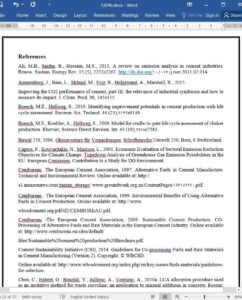Abstract
The benefits of using alternative fuels (AFs) in the cement industry include reduction of the use of non-renewable fossil fuels and lower emissions of greenhouse gases, since fossil fuels are replaced with materials that would otherwise be degraded or incinerated with corresponding emissions and final residues. Furthermore, the use of alternative fuels maximizes the recovery of energy. Seven different scenaria were developed for the production of 1 ton of clinker in a rotary cement kiln. Each of these scenaria includes the use of alternative fuels such as RDF (Refuse derived fuel), TDF (Tire derived fuel) and BS (Biological sludge) or a mixture of them, in partial replacement of conventional fuels such as coal and pet coke. The purpose of this study is to evaluate the environmental impacts of the use of alternative fuels in relation to conventional fuels in the kiln operation. The Life Cycle Assessment (LCA) methodology is used to quantify the potential environmental impacts in each scenario. The interpretation of the results provides the conclusion that the most environmentally friendly prospect is the scenario based on RDF while the less preferable scenario is the scenario based on BS.
1. Introduction
1.1. Cement production
Cement is an essential ingredient which fulfills basic needs such as the construction of housing and infrastructure indispensable to mankind and plays a vital part in the global construction industry. The production of cement is accompanied by high energy consumption, requires large quantities of resources and causes significant environmental impacts. It is responsible for nearly 5e7% of the global CO2 emissions, total CO2 anthropogenic emissions and substantial emissions of SO2, NOX and other pollutants (Hendricks et al., 1998; Van Oss and Padovani, 2002, 2003; Humphreys and Mahasenan, 2002; EIPPCB, 2010; Ali et al., 2011; Karagiannidis, 2012). Numerous studies have been done to evaluate CO2 emissions, energy consumption (Capros et al., 2001; CIF, 2003; and Gartner, 2004) and SO2 emissions (Josa et al., 2004, 2007), using Life Cycle Assessment (LCA) method. Emission of CO, NOX and SO2 from the cement industry contributes severely to greenhouse and acid rain effects (Zhang et al., 2011). Therefore cement production, as an energy intensive process, results in significant greenhouse gas (GHG) emissions. The reduction of emissions in this sector may lead to a significant decrease in the overall GHG releases (Boesch and Hellweg, 2010).
4. Conclusion
A methodology for the evaluation of the use of alternative fuels such as RDF (Refuse derived fuel), TDF (Tire derived fuel) and BS (Biological sludge) or a mixture of them, in partial replacement of conventional fuels such as coal and petcoke, taking into account environmental considerations, was developed. Seven different scenaria were considered for the production of 1 ton of clinker in a rotary cement kiln. A spreadsheet model was developed and used to estimate the design inventory data from the operation phase of all alternative scenaria. The Life Cycle Assessment (LCA) methodology was used to quantify the potential environmental impacts for each scenario.
The interpretation of the results provides the conclusion that the most environmentally friendly prospect is the scenario based on RDF, while the least preferable is the scenario based on BS.
The final outcome of this work can be of use to engineers involved in the cement industry, local authorities (especially scientists involved in decision-making) and practitioners of LCA.











